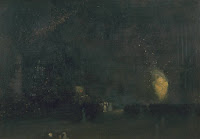 |
| James Abbott McNeill Whistler, Nocturne in Black and Gold, the Falling Rocket, 1875, oil on panel, 60.2 x 46.7 cm. |
James Abbott Whistler (he added the McNeill later in honor of his mother’s maiden name) was born in Lowell, Massachusetts in July of 1834. He spent part of his childhood in Russia, but returned to the United States after his father died in 1849. He was a difficult kid and grew into a sarcastic, monocled dandy. But he was also an incredible painter and printmaker, and will forever be remembered for his iconic Arrangement in Grey and Black No. 1 (better known as Whistler’s Mother).
 |
| James Abbott McNeill Whistler, Arrangement in Grey and Black No. 1, 1871, oil on canvas, 144.3 x 162.5 cm. |
Personally, I find the painting a bit boring.
Nocturne in Black and Gold, the Falling Rocket, on the other hand, is anything but boring. At first glance, it’s completely abstract. Tiny yellow and red specs pop against an undulating field of dark greenish blue. Then you see a few figures standing near the bottom of the canvas. A reflection hints at water, perhaps the white is a plume of smoke, and, you know, those specks kind of look like sparks. It’s ephemeral and ghostly, but a scene starts to emerge.
It turns out the scene is Cremorne Gardens on the River Thames. After four years immersed in the Parisian art scene, Whistler had settled in London just a few hundred yards from the notorious pleasure resort. The Gardens offered concerts, dancing, prostitution, and a nightly firework display that caught Whistler’s imagination not once, not twice, but at least three times!
Left: James Abbott McNeill Whistler, Nocturne in Blue and Gold, Old Battersea Bridge, 1872-5, oil on canvas, 68.3 x 51.2 cm.
Right: James Abbott McNeill Whistler, Nocturne in Black and Gold, the Fire Wheel, 1875, oil on canvas, 54.3 x 76.2 cm.
Right: James Abbott McNeill Whistler, Nocturne in Black and Gold, the Fire Wheel, 1875, oil on canvas, 54.3 x 76.2 cm.
Whistler painted The Falling Rocket from memory. Like the Impressionists, he wanted to convey a fleeting moment. Unlike the impressionists, that moment was not real. It was an amalgamation. Like the image that pops into your head when you see the word “fireworks.” To capture the effects of darkness, Whistler abstracted and flattened his subject, making it look almost like the Japanese prints he found so fascinating.
 |
| Utagawa Hiroshige, Fireworks at Ryogoku, 1858, woodblock print, 36.2 x 23.5 cm. |
The painting’s name emphasizes the abstraction. Like Kandinsky a generation or two later, Whistler used musical terms in his titles as a reference to the medium’s fundamentally abstract, but evocative, nature. A “nocturne” refers to a short, dreamy composition that suggests the night. The “in black and gold” part tells us that the ways the colors and forms interact is more important than the subject matter itself.
 |
| Vasily Kandinsky, Komposition V, 1911, oil on canvas, 190 x 275 cm. |
Falling Rocket’s avant-garde abstraction also plays a leading role in an interesting story. But this post is getting a bit long. So this is a “to be continued.” Go see some fireworks of your own!


No comments:
Post a Comment